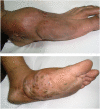A scoping review of mycetoma profile in Egypt: revisiting the global endemicity map
- PMID: 36084235
- PMCID: PMC9808524
- DOI: 10.1093/trstmh/trac085
A scoping review of mycetoma profile in Egypt: revisiting the global endemicity map
Abstract
Mycetoma is a chronic infectious disease endemic in sub-Saharan Africa (SSA), India and parts of South and North America. The epidemiologic profile of the disease in Egypt, which neighbours SSA, has not been explored previously. Therefore we conducted a scoping review of the literature on mycetoma in Egypt. We searched the literature comprehensively on MEDLINE and Google Scholar using free-text words and Medical Subject Headings and terms. Both published and non-peer-reviewed (grey literature) articles were included. The initial search identified 133 reports. Of these, only eight were found to be relevant and were included in the study. The total number of mycetoma patients was 59, reported between 1949 and 2015. There was a predilection for eumycetoma (44 of 59) patients (75%), while actinomycetoma constituted 15 patients (25%). Six patients were female, 28 were male and 25 were unreported. Children and adolescents constituted 3 of 59 (5%), 52 (88%) were adults and age was not provided for 4 patients. Only four patients (7%) were non-autochthonous. The incidence of mycetoma in Egypt is higher than previously reported. Egypt is probably a low-endemic country. An accurate estimate of the prevalence and epidemiology of mycetoma necessitates further research collaboration.
Keywords: Egypt; actinomycetoma; epidemiology; eumycetoma; neglected tropical diseases; northern Africa.
© The Author(s) 2022. Published by Oxford University Press on behalf of Royal Society of Tropical Medicine and Hygiene.
Figures







Similar articles
-
Mycetoma in Ecuador.Trans R Soc Trop Med Hyg. 2024 May 1;118(5):339-342. doi: 10.1093/trstmh/trad098. Trans R Soc Trop Med Hyg. 2024. PMID: 38214978 Free PMC article.
-
The global distribution of actinomycetoma and eumycetoma.PLoS Negl Trop Dis. 2020 Sep 24;14(9):e0008397. doi: 10.1371/journal.pntd.0008397. eCollection 2020 Sep. PLoS Negl Trop Dis. 2020. PMID: 32970667 Free PMC article. Review.
-
Epidemiological profile and spectrum of neglected tropical disease eumycetoma from Delhi, North India.Epidemiol Infect. 2019 Oct 22;147:e294. doi: 10.1017/S0950268819001766. Epidemiol Infect. 2019. PMID: 31637988 Free PMC article.
-
Review of 21 cases of mycetoma from 1991 to 2014 in Rio de Janeiro, Brazil.PLoS Negl Trop Dis. 2017 Feb 13;11(2):e0005301. doi: 10.1371/journal.pntd.0005301. eCollection 2017 Feb. PLoS Negl Trop Dis. 2017. PMID: 28192433 Free PMC article.
-
Mycetoma in China: A Case Report and Review of the Literature.Mycopathologia. 2019 Apr;184(2):327-334. doi: 10.1007/s11046-019-00324-z. Epub 2019 Mar 18. Mycopathologia. 2019. PMID: 30887177 Review.
Cited by
-
An updated list of eumycetoma causative agents and their differences in grain formation and treatment response.Clin Microbiol Rev. 2024 Jun 13;37(2):e0003423. doi: 10.1128/cmr.00034-23. Epub 2024 May 1. Clin Microbiol Rev. 2024. PMID: 38690871 Free PMC article. Review.
-
Epidemiology, risk factors, and awareness of mycetoma among residents in Eastern Sinnar locality, Sudan, 2021.J Glob Health. 2025 Jan 10;15:04005. doi: 10.7189/jogh.15.04005. J Glob Health. 2025. PMID: 39791422 Free PMC article.
-
Improving mycetoma case detection through the training of community health workers in Northern Uganda: protocol for a stepped-wedge cluster-randomized trial.Ther Adv Infect Dis. 2023 Sep 8;10:20499361231198332. doi: 10.1177/20499361231198332. eCollection 2023 Jan-Dec. Ther Adv Infect Dis. 2023. PMID: 37693860 Free PMC article.
-
Mycetoma Epidemiology and Clinical Findings in Mogadishu, Somalia.J Trop Med. 2025 May 28;2025:8864108. doi: 10.1155/jotm/8864108. eCollection 2025. J Trop Med. 2025. PMID: 40469909 Free PMC article.
-
Epidemiologic Aspects of Mycetoma in Africa.J Fungi (Basel). 2022 Nov 29;8(12):1258. doi: 10.3390/jof8121258. J Fungi (Basel). 2022. PMID: 36547591 Free PMC article. Review.
References
Publication types
MeSH terms
LinkOut - more resources
Full Text Sources
Research Materials

